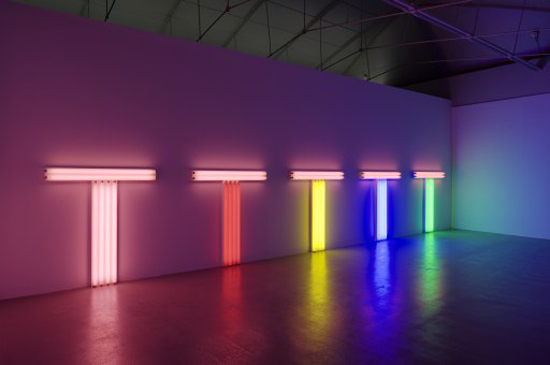Europe Rules That Dan Flavin and Bill Viola Artworks Are Not Art
ARTINFO
 Dan Flavin, untitled, 1987
Dan Flavin, untitled, 1987
BRUSSELS— Arguments about what does or doesn't constitute art come and go all the time, but it's rare that an aesthetic judgment actually acquires the force of law. But that's exactly what happened when the European Commission ruled that installations by Dan Flavin and Bill Viola cannot be classified as "art" by the galleries importing them. Instead of being subject to the five percent VAT (value-added tax) on artworks, such pieces will be taxed at the standard VAT, which will rise to 20 percent in 2011.
The issue first arose when Haunch of Venison imported six disassembled video installations by Viola into the United Kingdom in 2006 and also sought to import a light sculpture by Flavin, the Art Newspaper reports. The British customs office refused to apply the five percent tax rate for artworks, instead taxing the gallery £36,000 ($66,000). Haunch of Venison appealed this decision before the British VAT and Duties Tribunal and prevailed in 2008. But the European Commission decision has now reversed this British ruling, and applies to all European Union members.
In its decision, the European Commission describes the Flavin work as having "the characteristics of lighting fittings... and is therefore to be classified... as wall lighting fittings." In a discussion of Viola's work that really split hairs, the commission stated that Viola's video-sound installation cannot be considered sculpture "as it is not the installation that constitutes a 'work of art' but the result of the operations (the light effect) carried out by it."
The commission's insistence on seeing the Flavin and Viola installations purely as technical parts removed from any artistic context has raised eyebrows in artistic and judicial circles alike. Art lawyer Pierre Valentin, who represented Haunch of Venison in 2008 but is not involved in the current case, called the reasoning "absurd," according to the Art Newspaper. "To suggest, for example, that a work by Dan Flavin is a work of art only when switched on, is comical," he said. Valentin also referred to previous decisions by the U.K. and the Netherlands and said that this ruling conflicts with previous rulings of the European Court of Justice.
The ruling is not the first time a nation has embarrassed itself through an unsubtle appreciation of art at the customs office. Escorting a shipment of art to the United States in 1926, Marcel Duchamp was alerted by U.S. customs officials that Constantin Brancusi's "Bird in Space" — the seminal abstract tapered bronze sculpture — was not an artwork but rather fell under the classification of "Kitchen Utensils and Hospital Supplies" and was subject to that category's higher tariff. The photographer and art dealer Edward Steichen, who owned the work, brought the case to court.
The famous legal drama — in which Steichen's attorney fees were paid by Peggy Guggenheim — ended in November 1928 when a judge ruled that " while some difficulty might be encountered in associating it [the sculpture] with a bird, it is nevertheless pleasing to look at and highly ornamental, and as we hold under the evidence that it is the original production of a professional sculptor and is in fact a piece of sculpture and a work of art according to the authorities above referred to, we sustain the protest and find that it is entitled to free entry."